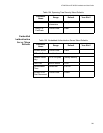AT-WA7500 and AT-WA7501 Installation and User’s Guide
335
point-to-point bridge
See also wireless bridge. A bridge that connects two wired networks with
similar architectures. Two access points can be used to provide a point-to-
point bridge between two buildings so that wired and wireless devices in
each building can communicate with devices in the other building.
power bridge
A power bridge combines power and data onto an Ethernet cable that is
connected to the access point with the power over Ethernet option.
primary bridging
Ethernet bridging on a root port. An access point uses primary bridging to
bridge frames to and from the Ethernet network on its root port. Note that
primary bridging is not the same as bridging to the primary LAN.
primary LAN
Also called the home IP subnet and root IP subnet. The IP subnet that
contains the root access point. The primary LAN is typically the LAN on
which the servers are located.
QFSK (Quad Frequency Shift Key)
A broadcasting method that shortens the range but doubles the throughput
as compared to the BFSK method. In access points using a 2.4 GHz
OpenAir radio, the radio can automatically switch between QFSK and
BFSK as needed if the transmit mode is set to AUTO.
remote IP subnet
An IP subnet that is separated from the primary IP subnet (primary LAN)
by a router. Remote IP subnets communicate with the primary LAN
through IP tunnels. A remote IP subnet is a type of secondary LAN.
root access point
The access point with the highest root priority becomes the root of the
network spanning tree. If the root becomes inactive, the remaining root
candidates negotiate to determine which access point becomes the new
root. The root can be used to set system-wide flooding and RF
parameters. The root is also the only node in the network that can
originate IP tunnels.


















